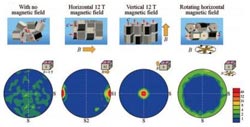Enhancing battery performance

This is a schematic illustration of the crystal structure of LiCoO2.<br><br>Credit: Reproduced from APL Materials: http://dx.doi.org/10.1063/1.4824042<br>
The ever-increasing market for portable electronic devices such as laptops, cell phones and MP3 players has resulted in an equally heavy demand for secondary batteries — more commonly known as rechargeable batteries — Lithium-ion (Li-ion) being among the most popular.
Scientists and engineers worldwide are seeking ways to improve the power density, durability and overall performance of Lithium-ion batteries, and in a recent paper in the AIP Publishing journal APL Materials, Japanese researchers from a public-private team report an advance in Li-ion battery technology that they describe as a major breakthrough.
They fabricated a cathode (positive electrode) of lithium cobalt oxide (LiCoO2) in which the compound's individual grains are aligned in a specific orientation. The researchers claim that this yields a significantly higher-performing battery than one with a randomly-oriented LiCoO2 cathode.
Primary, or non-rechargeable, batteries and secondary batteries both produce current through an electrochemical reaction involving a cathode, an anode, and an electrolyte (an ion-conducting material). However, apply an outside current to a secondary battery and the negative-to-positive electron flow that occurs during discharge is reversed. This allows the battery to restore lost charge.
“In a lithium-ion battery, lithium ions move from the anode to the cathode during discharge and back when charging,” said Tohru Suzuki, a co-author on the APL Materials paper. “The material in the cathode has a layered structure to facilitate intercalation [insertion] of the lithium ions; if the structure is oriented in a specific fashion, the lithium ions have better access to the lattice and, in turn, charge-discharge performance is improved.”
Using a rotating magnetic field, the researchers were able to fabricate the ideal textured microstructure of the individual LiCoO2 grains making up the cathode: a perpendicular alignment of the c-plane (the vertical side) and a random orientation of the c-axis. Unlike cathodes where the microstructures in both the c-plane and c-axis are randomly oriented, the specialized grains allow easy access for lithium ions while relaxing the stress associated with intercalation.
“This yields a highly efficient flow of electrons in both directions,” Suzuki said.
Collaborating on the work were researchers from the National Institute for Materials Science (Tsukuba, Japan), the NIMS-Toyota Materials Center of Excellence for Sustainable Mobility (Tsukuba, Japan) and Toyota Motor Corporation's Higashifuji Technical Center (Susono, Japan).
The article, “Ideal design of textured LiCoO2 sintered electrode for Li-ion secondary battery” by Hideto Yamada, Tohru S. Suzuki, Tetsuo Uchikoshi, Masato Hozumi, Toshiya Saito and Yoshio Sakka appears in the journal APL Materials. See: http://dx.doi.org/10.1063/1.4824042
ABOUT THE JOURNAL
APL Materials is a new open access journal featuring original research on significant topical issues within the field of materials science. See: http://aplmaterials.aip.org
Media Contact
All latest news from the category: Materials Sciences
Materials management deals with the research, development, manufacturing and processing of raw and industrial materials. Key aspects here are biological and medical issues, which play an increasingly important role in this field.
innovations-report offers in-depth articles related to the development and application of materials and the structure and properties of new materials.
Newest articles

Superradiant atoms could push the boundaries of how precisely time can be measured
Superradiant atoms can help us measure time more precisely than ever. In a new study, researchers from the University of Copenhagen present a new method for measuring the time interval,…

Ion thermoelectric conversion devices for near room temperature
The electrode sheet of the thermoelectric device consists of ionic hydrogel, which is sandwiched between the electrodes to form, and the Prussian blue on the electrode undergoes a redox reaction…

Zap Energy achieves 37-million-degree temperatures in a compact device
New publication reports record electron temperatures for a small-scale, sheared-flow-stabilized Z-pinch fusion device. In the nine decades since humans first produced fusion reactions, only a few fusion technologies have demonstrated…





















